20 Types of Trees in New York (With Pictures)
-
Pete Ortiz
- Last updated:

New York State is home to a host of coniferous and deciduous trees. Thanks to its diverse and adaptable climate, many tree species find it easy to grow in this area. It’s estimated that there are over 5.2 million trees in New York City alone. The number increases as you venture out to other parts of this state.
Read on and get to know all these different tree species growing in this part of the country. We have classified them into two major categories: conifers and deciduous trees. We will also further break it down into different types, such as fir, pine, maple, cedar, oak, spruce, ash, and cherry trees.
Conifers Trees in New York
Conifers are tree species that grow in colder climates and are adaptable to harsh winter conditions. These trees don’t change color or shed leaves in fall. Instead, most conifers are evergreen, have needle-like leaves, and produce cones.
The 20 Types of Trees in New York
1. Balsam Fir (Abies balsamae)
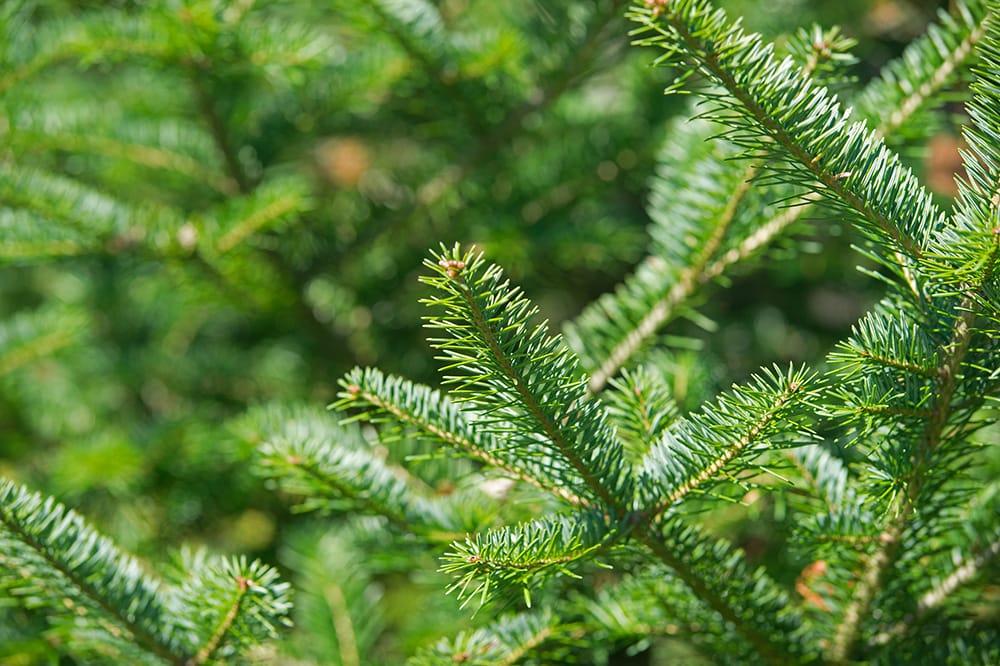
| Height: | 45–75 inches |
| Trunk Diameter: | 20–25 inches |
| USDA Hardiness Zone: | 3–5 |
| Estimated Lifespan: | Up to 150 years |
The Balsam Fir is an evergreen tree that thrives in colder climates. It has a slow growth rate, and it keeps its dark green foliage all year round.
As a young tree, it has a smooth, grayish bark that becomes rough and scaly as it matures. Once it matures, it forms a narrow, symmetrical crown. The leaves are similar to needles and grow to be 30 millimeters long, but they’re shorter the higher you climb.
It’s better to grow the tree in areas where the tree can get full sun or partial shade. In terms of soil preference, the Balsam Fir requires moist and well-draining soil. It’s among the salt-tolerant species in this state.
2. Black Spruce (Picea mariana)

| Height: | 15–50 feet |
| Trunk Diameter: | 6–20 inches |
| USDA Hardiness Zone: | 3–6 |
| Estimated Lifespan: | Up to 300 years |
The Black Spruce is among the smallest trees you can find in New York. It is another slow-growing tree that forms a cluster of branches as it increases in height.
Its leaves are needle-like with a blue-green color. The short leaves are four-sided and stiff, facing in all directions on the twigs. The tree produces small purple cones that remain hanging on the tree for years.
The best areas for Black Spruce trees are those with wet, organic soils. Areas with marshes tend to slow down their growth rate, but the tree can tolerate poor soil conditions.
3. Norway Spruce (Picea abies)
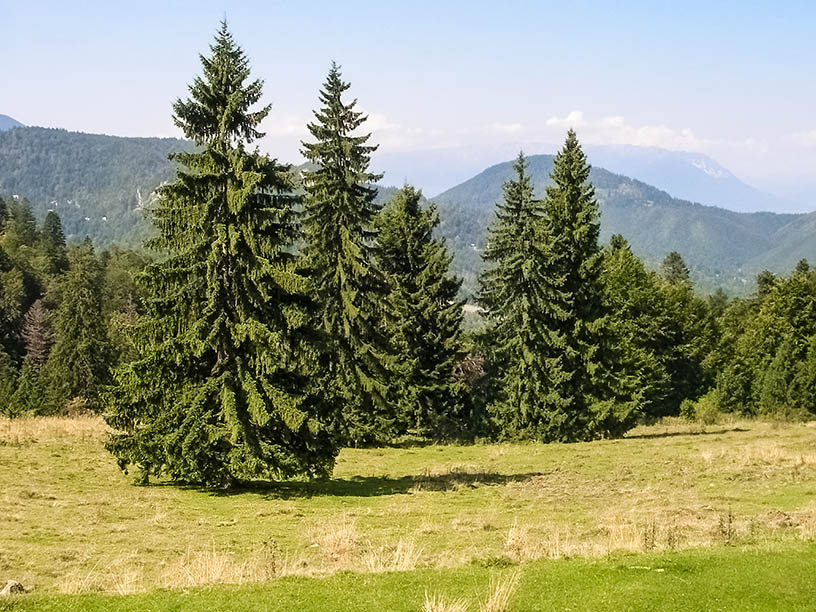
| Height: | 115–180 feet |
| Trunk Diameter: | 1–1.5 meters |
| USDA Hardiness Zone: | 3–7 |
| Estimated Lifespan: | 300–400 years |
The Norway Spruce is also known as the European Spruce. It is among the fastest-growing Spruce trees in New York, growing at a rate of 1 meter each year for the first 25 years. Many people are fond of this tree, and it is mostly used as a Christmas tree. Its fast growth rate makes it an ideal ornamental tree.
The tree has needle-like and dark blue-green leaves with dull tips and four sides. It produces reddish-green cones that mature to be brown.
As you grow the Norway Spruce, ensure it gets a minimum of 6 hours of full sun exposure. It thrives in well-draining, moist, acidic loam soil, but it can still grow in clay soils and is a bit drought tolerant.
4. Red Spruce (Picea rubens)
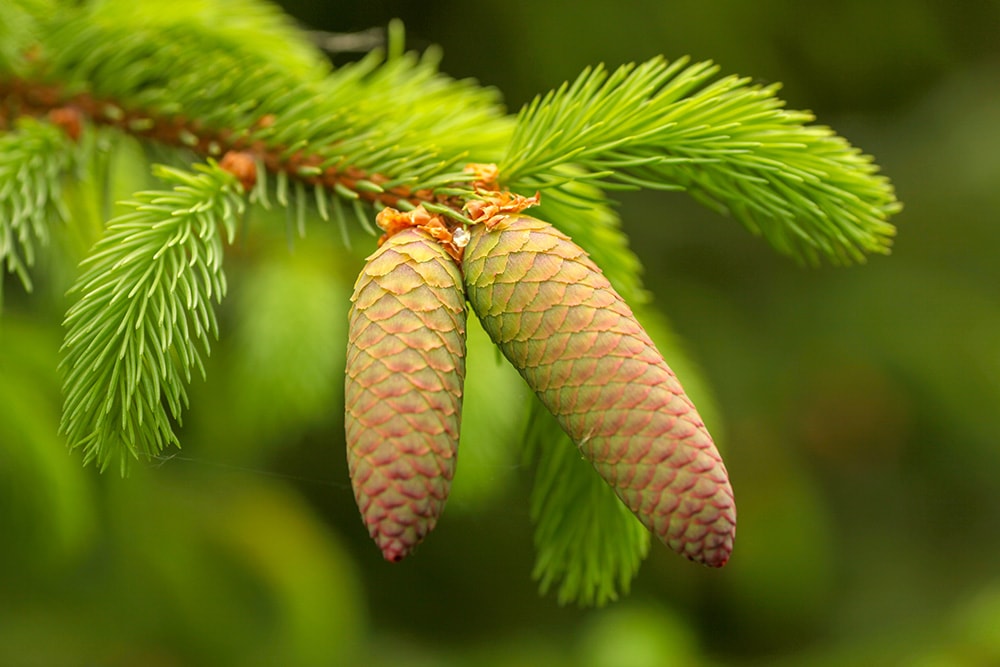
| Height: | 59–131 feet |
| Trunk Diameter: | 24 inches |
| USDA Hardiness Zone: | 2–6 |
| Estimated Lifespan: | 350 years |
The Red Spruce is also known as the Eastern Spruce. This evergreen conifer thrives in cool climates. As a perennial, it is a late-successional tree that has a slow to moderate growth rate.
The tree has needle-like, yellow-green leaves that grow to be 12–15 millimeters long. At the top, there’s a conical crown that’s narrow with a sharp point. The bark is reddish on the inside and dark brown on the outside.
Red Spruce is common in areas with cold winters and moist summers. It is shade tolerant, thus it can grow slowly under the cover of bigger trees. It prefers well-drained, loamy to sandy soil.
5. White Spruce (Picea glauca)
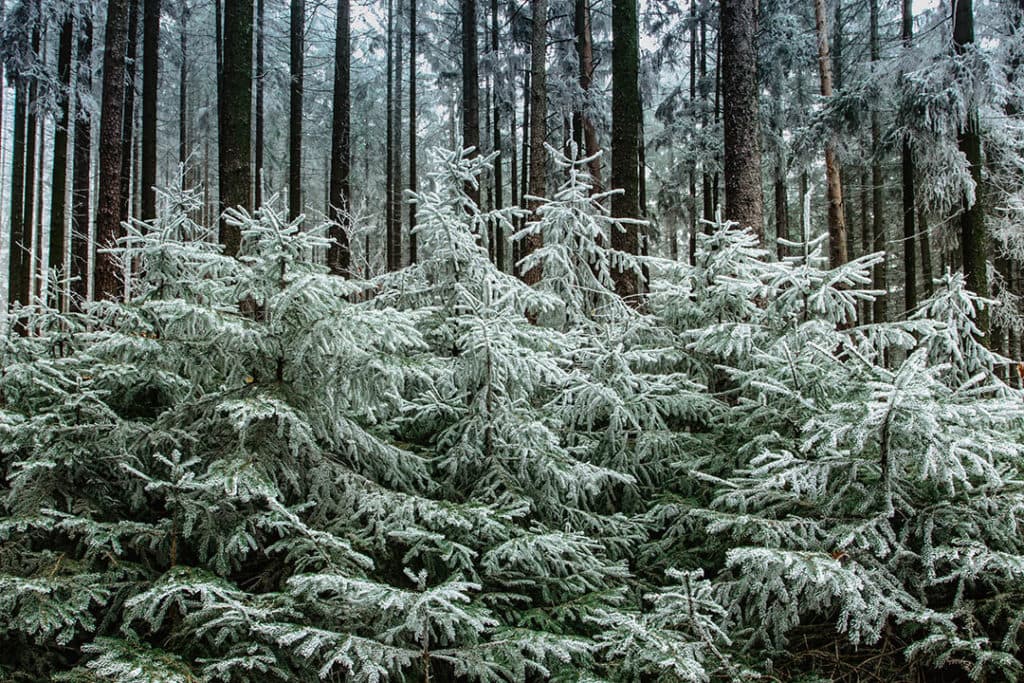
| Height: | 50–100 feet |
| Trunk Diameter: | 3 feet |
| USDA Hardiness Zone: | 2–6 |
| Estimated Lifespan: | 250–350 years |
The White Spruce is native to the cold regions of North America. It is also known as the Black Hills Spruce or the Canadian Spruce. It’s found in New York and most northern parts of the country and up into Canada.
This evergreen tree grows large with aromatic foliage. It tends to form a uniform habitat and cylindrical cones as it gets older. The leaves resemble needles with blue-green shades at the top and blue-white color at the bottom.
It grows better in loamy or sandy soil that remains moist for a better part of the year. It thrives with full sun exposure and is drought-tolerant. It can withstand high frost and extremely cold conditions as well.
6. Red Cedar (Juniperus virginiana)
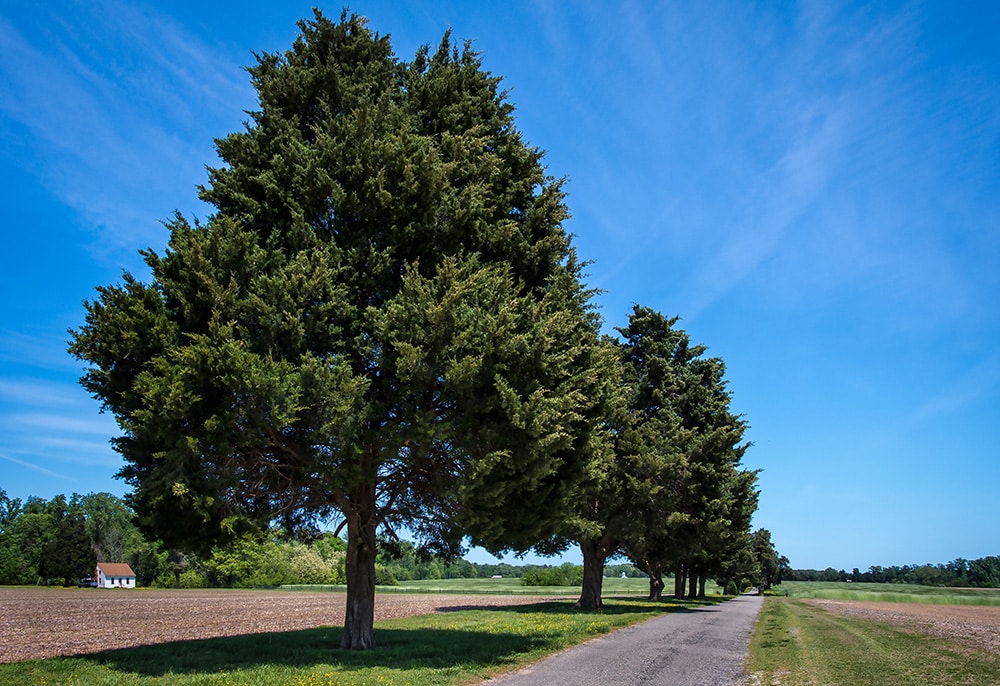
| Height: | 50–100 feet |
| Trunk Diameter: | 3 feet |
| USDA Hardiness Zone: | 6–8 |
| Estimated Lifespan: | 1,000 years |
As a native of North America, the Red Spruce is among the trees you can find in New York. It’s known by other names such as Virginian Juniper, Eastern Red Cedar, and Red Juniper. It’s a coniferous tree with a slow growth rate and a short trunk.
The tree grows to have a reddish-brown bark. It has two types of leaves: scale-like adult leaves that are 2–4 millimeters long and needle-like young leaves that are 5–10 millimeters long. It produces cones resembling berries that are dark purple.
As a hardy tree species, the Red Spruce is among the pioneer trees that repopulate barren landscapes. Its wood is also fragrant. This tree requires full sun exposure to partial shade and can thrive in highly acidic soils.
7. Northern White Cedar (Thaju occidentalis)

| Height: | 49 feet |
| Trunk Diameter: | 3 feet |
| USDA Hardiness Zone: | 2–8 |
| Estimated Lifespan: | 800 years |
Another example of an evergreen conifer in New York is the Northern White Cedar. It’s also known as the Eastern Cedar or the Arborvitae. This tree tends to remain small or medium-sized for most of its life.
It has needle-like scale leaves that make small branches appear flat. The leaves are light green with a pleasant aromatic scent. It produces 0.5-inch-long cones that form huge clusters on one tree.
The Northern White Cedar thrives in wet forested areas where the soil rarely gets dry. It can withstand cold and frosty climates, but it requires sun exposure for at least 6 hours per day.
8. Eastern White Pine (Pinus strobus)
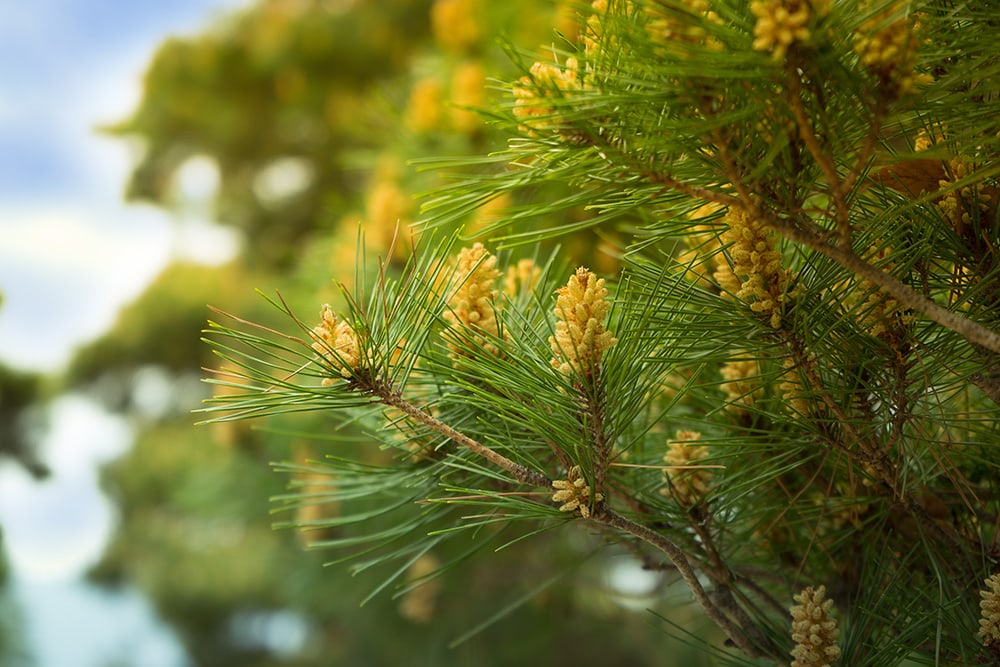
| Height: | 230 feet |
| Trunk Diameter: | 1.6 meters |
| USDA Hardiness Zone: | 3–8 |
| Estimated Lifespan: | 200–250 years |
The Eastern White Pine is also known as the Soft Pine, Northern White Pine, or the White Pine. This species is native to eastern parts of North America. It’s among the largest pine species in New York and has a lot of value to tree growers.
This tree has blue-green, needle-like leaves that grow to be 5–13 centimeters long. It produces slim cones 8–16 centimeters wide. After every 3–5 years, the tree experiences a spike in cone production.
As a hardy tree, the Eastern White Pine has a fast growth rate. It’s fire-resistant and it requires a minimum of 4 hours of direct sunlight. The tree grows better in well-draining acidic soils.
9. Pitch Pine (Pinus rigida)
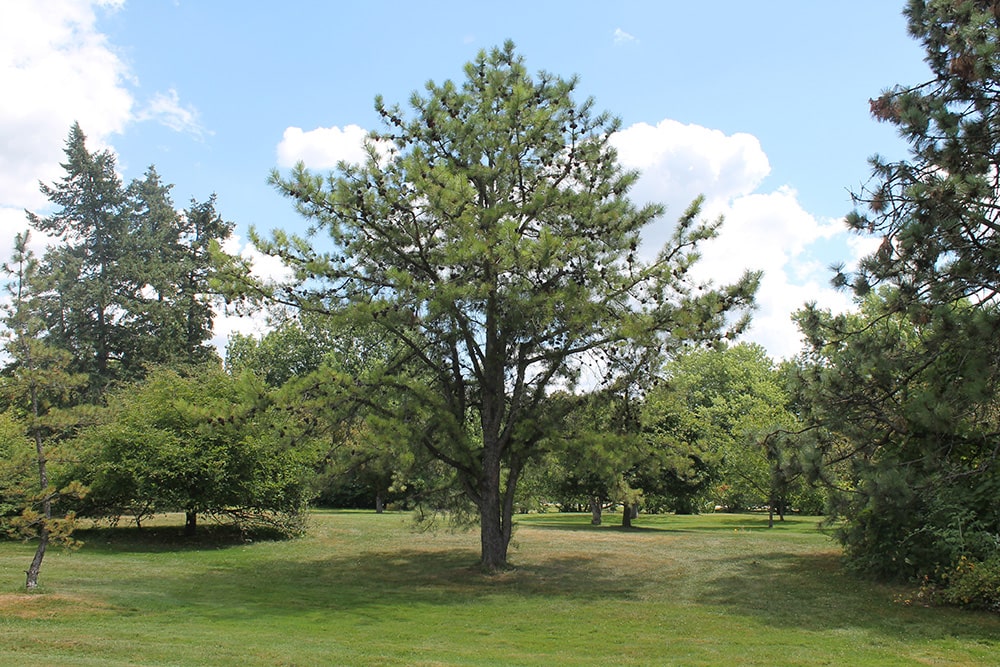
| Height: | 20–98 feet |
| Trunk Diameter: | 1–3 feet |
| USDA Hardiness Zone: | 4–7 |
| Estimated Lifespan: | 78–170 years |
Small pine trees native to North America include the Pitch Pine. It’s among the most adaptive trees with the capacity for regenerative growth after damage. In such cases, you can notice some twisting branches growing in all directions.
This pine has needle-like leaves that tend to grow three at a time. It produces long, oval cones with prickly scales. There’s a thick bark that forms as the tree matures and is among its main protection against fire and other damaging factors.
It’s best to have Pitch Pine in areas that enjoy full sun exposure for many hours in a day. The tree can thrive in numerous types of soils as long as they’re acidic. It’s drought-resistant and can keep growing even in extreme conditions with little water available.
10. Red Pine (Pinus resinosa)
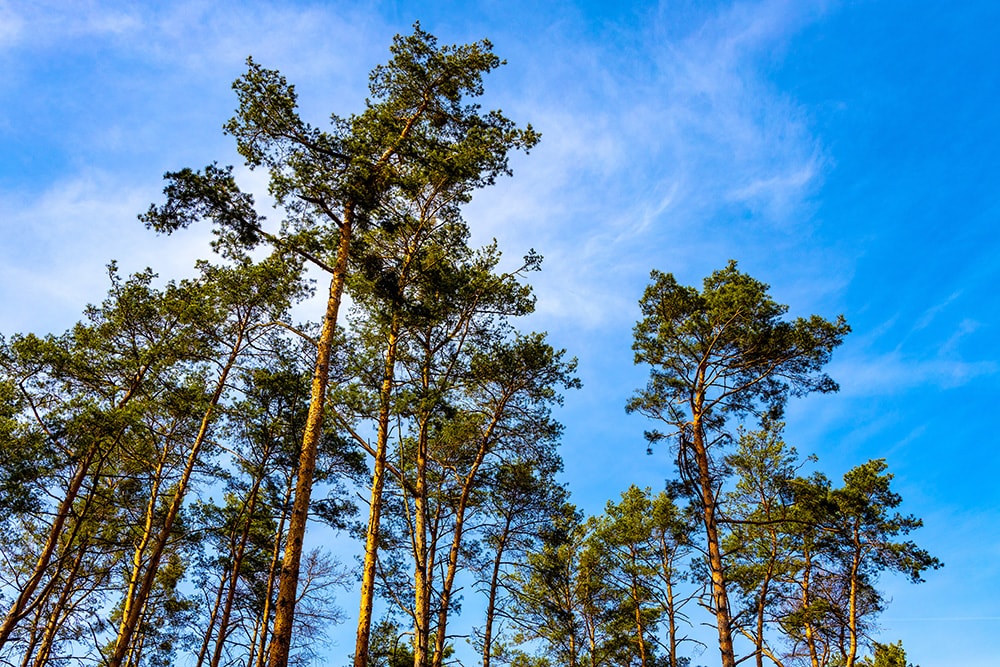
| Height: | 66–115 feet |
| Trunk Diameter: | 3 feet |
| USDA Hardiness Zone: | 3–6 |
| Estimated Lifespan: | 500 years |
Red Pine is native to North America. It has long been sought after for its wood. Commercially, the wood comes in handy for pulp or timber production.
The tree grows tall and straight with a conical crown at the top. It has a thick, gray-brown bark with visible fissures of red all around. The red fissures give the tree its name and distinctive characterization.
Spots with lots of wind can be a good area to have Red Pine. The tree is shade-intolerant and prefers full sun exposure. It thrives in well-draining soil and can keep growing for many years under ideal conditions.
11. Scotch Pine (Pinus sylvestris)

| Height: | 115 feet |
| Trunk Diameter: | 3 feet |
| USDA Hardiness Zone: | 3–7 |
| Estimated Lifespan: | 150–300 years |
Among the most beautiful evergreen trees in New York is the Scotch Pine. This adaptable species from the Pine family thrives in different climatic conditions. It’s a famous Christmas tree due to its shape and ability to maintain the green needles for a long time. It has blue-green leaves on mature trees. As winter begins, the leaves turn to a dark, yellow-green color.
Scotch Pines are slow-growing, preferring loamy to sandy acidic soils. Dry soils are ideal as the tree is somewhat drought tolerant. It requires lots of sun exposure to keep growing.
 Deciduous Trees in New York
Deciduous Trees in New York
Deciduous are trees whose leaves change color and fall off in autumn. These trees range in size from small to giant trees. The leaves form a strata arrangement with the canopy at the top to permit better light penetration.
In spring, the leaves grow back, and this is also the time flowering takes place. Spring and summer are the main growing seasons. They lay dormant in winter.
12. White Oak (Quercus alba)
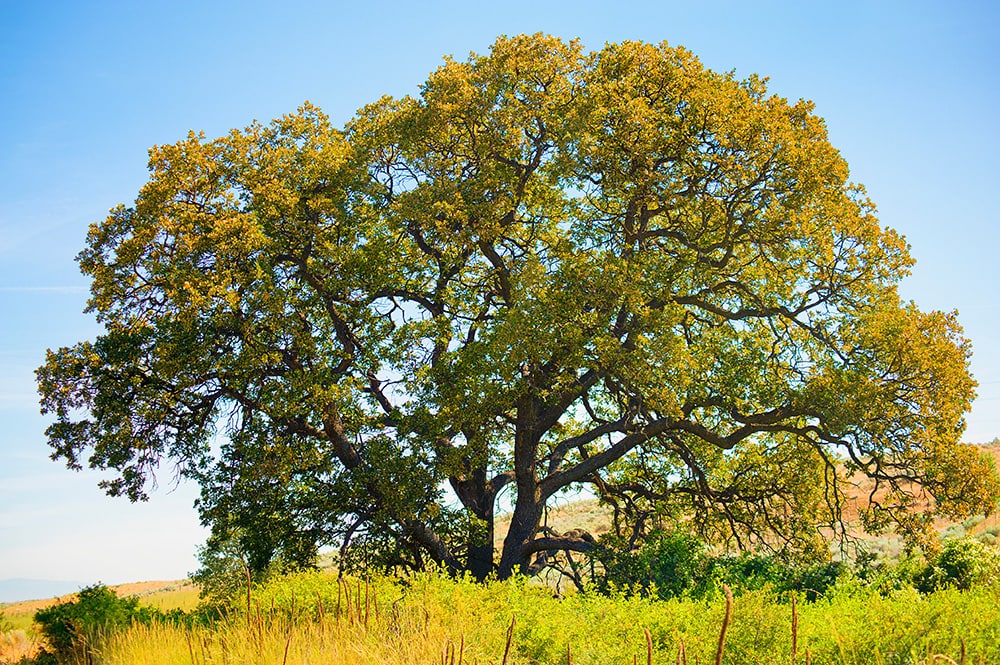
| Height: | 80–100 feet |
| Trunk Diameter: | 145 feet |
| USDA Hardiness Zone: | 3–9 |
| Estimated Lifespan: | 200–300 years |
New York is home to many types of hardwoods including the White Oak. Despite its name, the White Oak doesn’t have white bark. Instead, it’s usually light gray. It gets its name from the color of the processed wood at the timber yard.
Spring sees the tree come back to life and produce delicate, silvery-pink leaves. Eventually, the leaves will turn yellow-green and grow to be up to 216 millimeters long. Sexual maturity for the White Oak starts when the tree is 20 years old.
The tree requires 4 hours of direct sunlight every day in rich and moist acidic soils. It has a deep tap root system that seeks out moisture, making it more drought-tolerant. Although this tree is present in New York, it’s worth noting that it is the official tree of the state of Illinois.
13. Bur Oak (Quercus macrocarpa)
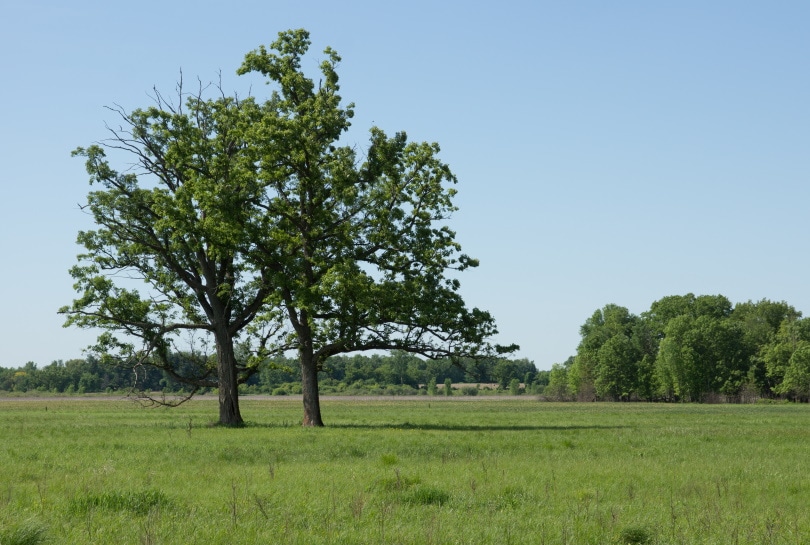
| Height: | 98–160 feet |
| Trunk Diameter: | 10 feet |
| USDA Hardiness Zone: | 3–8 |
| Estimated Lifespan: | 200–300 years |
The Bur Oak also known as the Scrub Oak or the Blue Oak is native to the eastern regions of North America. It’s known to produce the largest acorns of any other oak tree growing in this area.
This massive oak tree has various shapes of leaves that are 7–15 centimeters long. It produces greenish-yellow catkins in spring and huge 5-centimeter-long acorns. These acorns are popular food sources for the local wildlife.
The best place to grow a Bur Oak is somewhere with alkaline, sandy soil with good drainage. It needs lots of unfiltered sunlight, especially in spring and summer.
14. Chestnut Oak (Quercus montana)
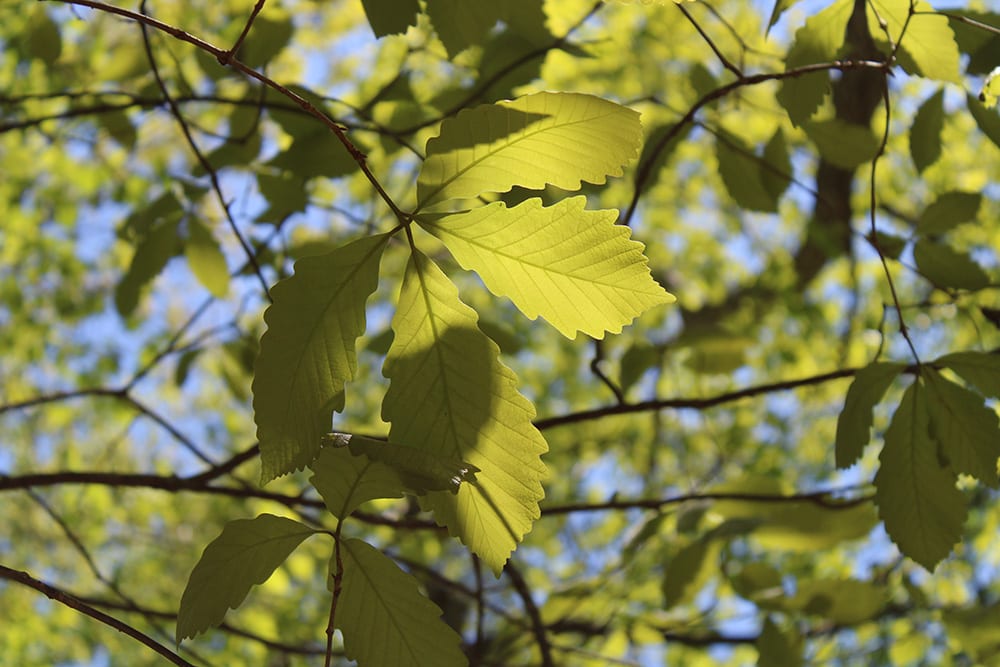
| Height: | 59–72 ft |
| Trunk Diameter: | 59–72 feet |
| USDA Hardiness Zone: | 4 |
| Estimated Lifespan: | 300–400 years |
The Chestnut Oak is an adaptable tree that grows even in the harshest conditions. It’s possible to find it in steep and rocky areas. Most folks love its huge crowns that provide ample shade during hot summer months.
It is small when compared to other oaks. It has yellow-green leaves that start forming in spring. It flowers in spring to produce some hairy catkins. Acorns are available every year, growing as singles or in pairs.
These aren’t ideal trees for timber since the Chestnut Oak rarely grows straight. However, those rare trees that do grow straight under the right conditions are quite valuable. Chestnut Oak barks produce natural tanning, making them quite valuable.
15. American Mountain Ash (Sorbus americana)
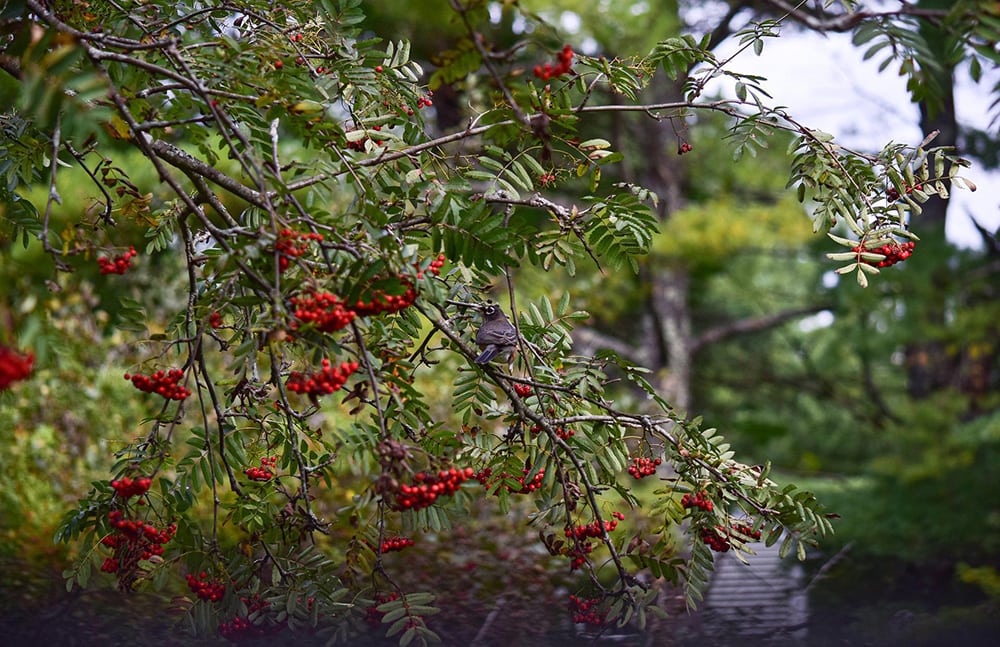
| Height: | 10–30 feet |
| Trunk Diameter: | 10 feet |
| USDA Hardiness Zone: | 3–6 |
| Estimated Lifespan: | 400 years |
The American Mountain Ash is a small deciduous tree that at times resembles a shrub. It is native to the northeastern part of North America.
The tree has a smooth, light gray and scaly bark when mature. It has long leaves ranging from 15–25 centimeters with a rounded base. Once all the leaves grow back, the tree flowers. It produces 0.75-inch-long, dark red winter buds.
Spots with full sun exposure are perfect for the American Mountain Ash. However, it has some shade tolerance. It thrives in well-draining acidic soils, but it doesn’t do well on hot and humid summer days.
16. White Ash (Fraxinus americana)
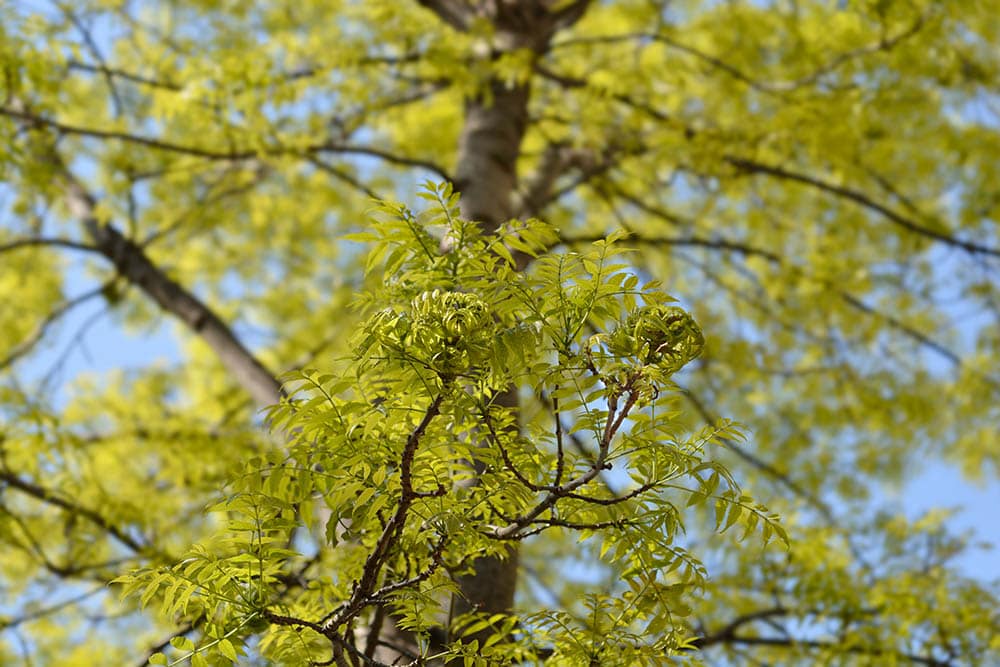
| Height: | 50 to 80 inches |
| Trunk Diameter: | 40 to 40 inches |
| USDA Hardiness Zone: | 4–9 |
| Estimated Lifespan: | 260 to 300 years |
Many parks and backyards are home to the White Ash; people love it because of its shade. The tree tends to produce the loveliest fall colors ranging from maroon to deep purple and yellow. It has immense landscape value in New York and other parts of the country.
The tree has yellow-green leaves that are light gray underneath. It’s among the most sought-after trees for its white wood that’s also quite dense. However, this tree tends to do better away from commercial areas in spots with less pollution.
It grows at a medium rate in well-draining acidic loamy and sandy soils. It prefers full sun exposure with a minimum of 6 hours.
17. Black Ash (Fraxinus nigra)
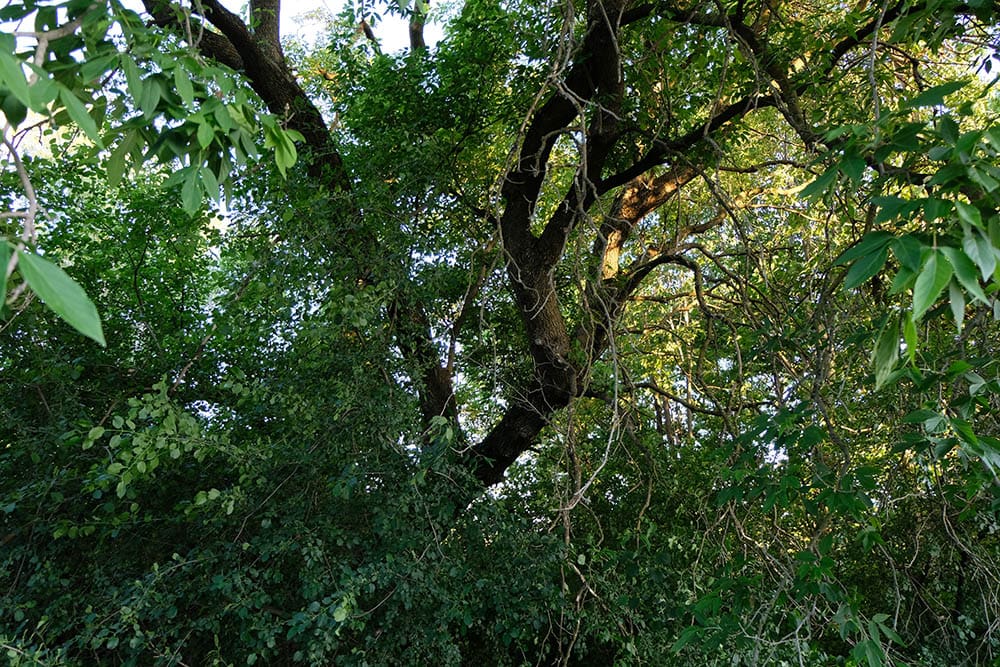
| Height: | 49 to 66 feet |
| Trunk Diameter: | 60 cm |
| USDA Hardiness Zone: | 2–5 |
| Estimated Lifespan: | 150 years |
Another example of an Ash tree growing in New York is the Black Ash. This small slow slow-growing hardwood tree thrives in bogs. It’s the best tree to plant in areas with poor drainage and lots of moisture that would otherwise affect other tree species.
The Black Ash has a thick and corky gray bark that gets scalier as the tree matures. While other trees produce spring leaves then flowers, the opposite happens for the Black Ash. The tree flowers in early spring then the leaves follow.
In fall, the tree has amazing yellow foliage. Before winter, it loses all its leaves. Seed dispersal takes place via wind, but they only germinate when the next growing season starts.
18. Black Cherry (Prunus serotina)
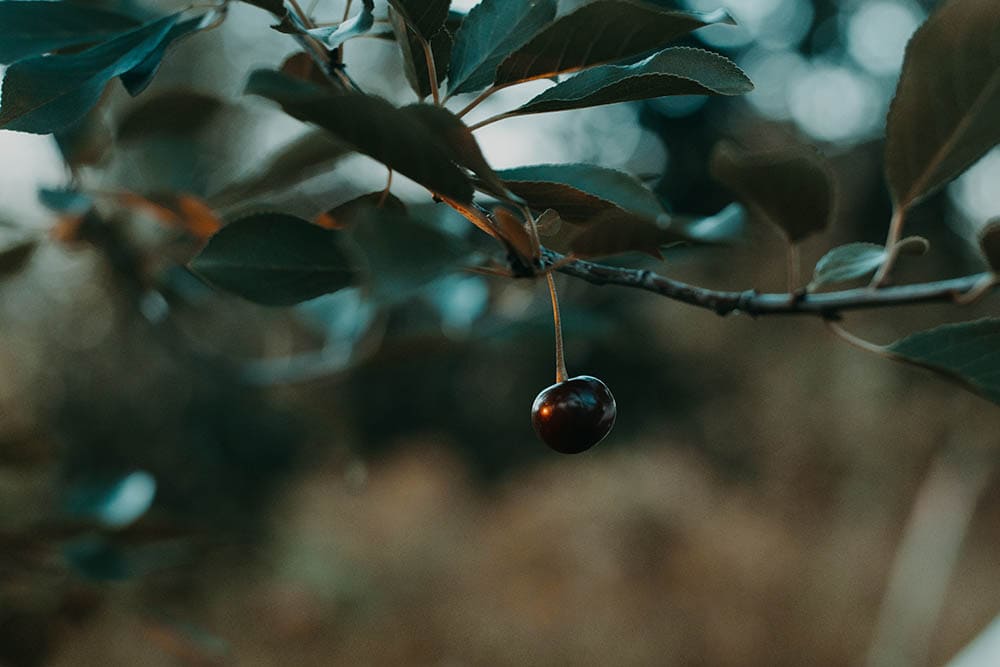
| Height: | 49 to 79 feet |
| Trunk Diameter: | up to 50 feet |
| USDA Hardiness Zone: | 2–8 |
| Estimated Lifespan: | 250 years |
The Black Cherry, also known as the Mountain Black Cherry or the Rum Cherry is a dominant tree in Western New York. It is fast fast-growing and among the easiest trees to identify on a field.
It has greenish-yellow leaves with finely toothed margins. In fall, the leaves turn yellow and red. In spring, it blooms to produce small and white flowers, each with 5 petals.
19. Pin Cherry (Prunus pensylvanica)

| Height: | 16 to 49 feet |
| Trunk Diameter: | 10 to 51 cm |
| USDA Hardiness Zone: | 2–5 |
| Estimated Lifespan: | 30 to 35 years |
The Pin Cherry is also known as the Red Cherry, Pin Cherry or the Fire Cherry, native to North America. It grows to be a shrub or a small tree with a straight trunk that’s not too long and a round-topped crown.
Flowering happens in spring when the tree produces blooms in clusters of 5 to 7. This tree produces drupe fruits measuring 4 to 8mm.
The Pin Cherry grows from seed into a mature tree while in the forest. It has a shallow root system and is among the shade-intolerant trees you can find in New York. In fall, the leaves turn pale yellow before they all fall off.
20. Red Maple (Acer rubrum)

| Height: | 60–90 feet |
| Trunk Diameter: | 40–60 inches |
| USDA Hardiness Zone: | 3–9 |
| Estimated Lifespan: | 60–90 years |
The Red Maple is among the most common trees not only in New York but all over the northern region because it is adaptable to varying conditions. It is also known as the Swamp Maple or the Water Maple.
The height depends on the growing conditions. It tends to be medium or large. In fall, the leaves turn to brilliant red, and it begins to form buds.
Red Maple has a thin bark that’s prone to damage during ice storms. It can thrive well in huge habitats and is tolerant to flooding. Animals in the wild use it as a source of food, but it’s also a good urban tree thanks to its short root system.
Conclusion
New York is home to numerous tree species. These trees are spread throughout the state depending on the environment. While some thrive in moist and well-draining soils, there are those that thrive in bogs and swamps.
In this state, you can come across conifers and hardwoods. All thrive with ample sun exposure. While conifers remain evergreen, hardwoods’ leaves turn color in autumn and proceed to fall off the tree. New leaves and blooms take place the following spring.
Although there are over 5 million trees in New York, the above listed are the most common tree species you can expect to find in this state.
See also:
Featured Image Credit: Rudy Balasko, Shutterstock
Contents


 Deciduous Trees in New York
Deciduous Trees in New York